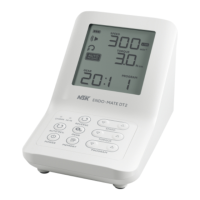44
EMC Information (Electromagnetic Compatibility Information)
Cables and
accessories
Maximum
length
Complies with
Motor handpiece cord
AC adaptor
1�5 m
Plug side : 1�8m
Unit side : 1�8m
RF emissions, CISPR11,
Harmonic emissions,
Voltage fluctuations/ flicker emission
Electrostatic discharge (ESD)
Surge
Voltage dips, short interruptions and
voltage variations on power supply input
lines
Power frequency (50/60Hz) magnetic field
Conducted RF
Radiated RF
Class B/ Group 1
IEC61000-3-2, Class A
IEC61000-3-3
IEC61000-4-2
IEC61000-4-5
IEC61000-4-11
IEC61000-4-8
IEC61000-4-6
IEC61000-4-3
Recommended separation distances between portable and mobile RF communications equipment and the
ENDO-MATE DT2
The ENDO-MATE DT2 is intended for use in an electromagnetic environment in which radiated RF disturbances are
controlled� The customer or the user of the ENDO-MATE DT2 can help prevent electromagnetic interference by
maintaining a minimum distance between portable and mobile RF communications equipment (transmitters) and
the ENDO-MATE DT2 as recommended below, according to the maximum output power of the communications
equipment�
Rated maximum output
power of transmitter
W
Separation distance according to frequency of transmitter
150 kHz to 80 MHz
d = 1�2
√
P
80 MHz to 800 MHz
d = 1�2
√
P
800 MHz to 2�5 GHz
d = 1�2
√
P
0�01 0�12 0�12 0�23
0�1 0�38 0�38 0�73
1 1�2 1�2 2�3
10 3�8 3�8 7�3
100 12 12 23
For transmitters rated at a maximum output power not listed above, the recommended separation distance d in
meters (m) can be estimated using the equation applicable to the frequency of the transmitter, where P is the
maximum output power rating of the transmitter in watts (W) according to the transmitter manufacturer�
NOTE1 At 80 MHz and 800 MHz, the separation distance for the higher frequency range applies�
NOTE2 These guidelines may not apply in all situations� Electromagnetic propagation is affected by absorption
and reflection from structures, objects and people�

